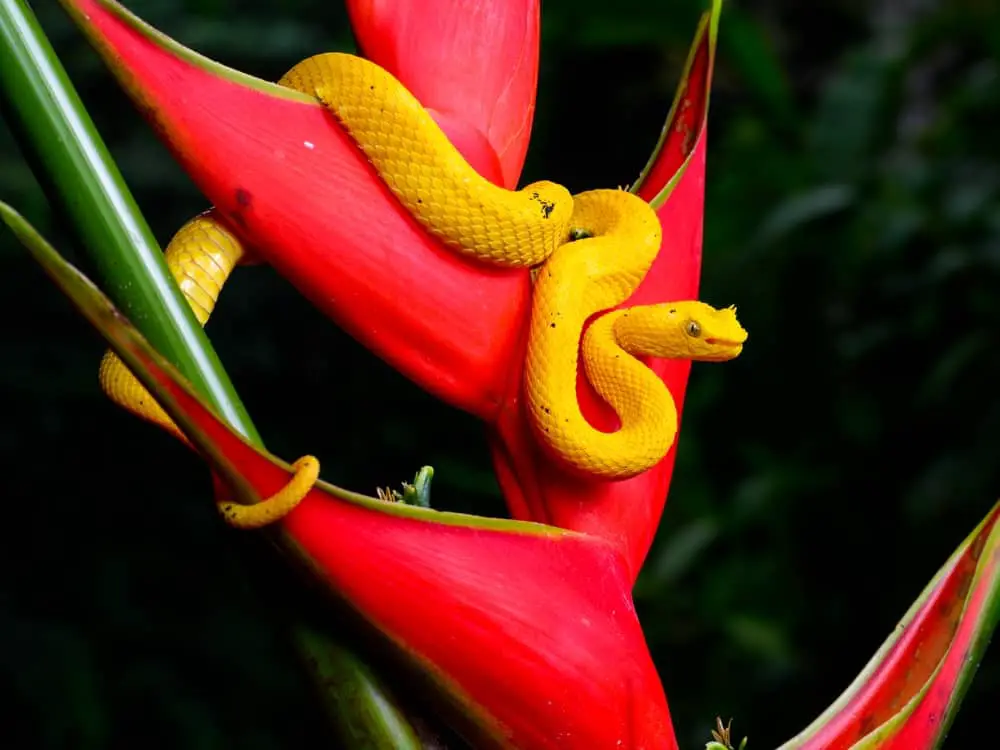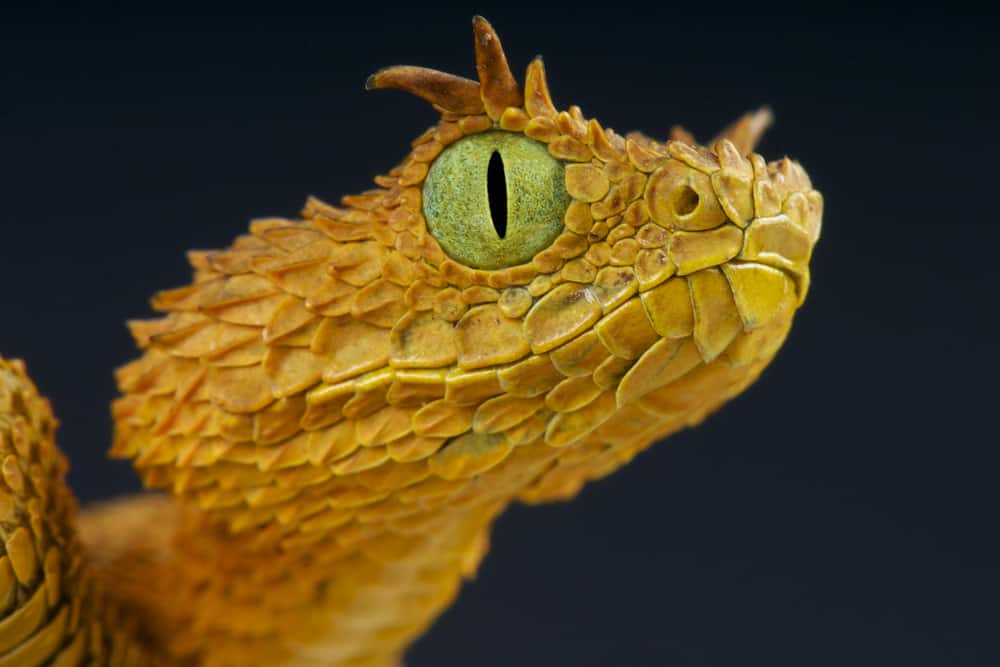The Eyelash Viper (Bothriechis schlegeli) is a species of venomous viper found throughout Central and South America. It is an important member of the snake family, occupying habitats from tropical rainforests to semi-arid scrublands.
The unique physical characteristics of this species offer researchers insight into its behavior and ecology, making it one of the most studied vipers in the world. This article will provide an overview of current research on the biology, physiological adaptations and life history of the Eyelash Viper.
Body Structure:
The Eyelash Viper has several distinctive features that distinguish it from other snakes. Its body shape is slender yet robust with an average length ranging between 30-65 cm for adults and 15-30cm for juveniles; however larger specimens can reach up to 100 cm.
Coloration varies depending on geographic location but typically consists of shades of black, brown or green with distinct white markings along its back and underside. Additionally, these snakes possess prominent ‘eyelashes’ above their eyes which give them their name as well as heat sensing loreal pits located near their nostrils used for locating prey.
The defensive capabilities of this species are impressive, allowing them to survive in harsh environments where other predators may not thrive. They have highly developed venom glands containing potent hemotoxic components capable of immobilizing prey items quickly while also providing protection against potential threats such as predators or humans.
In addition to venom production they possess a series of large spines down either side of their bodies which serve as protection when threatened by potential enemies or during mating rituals between males competing for females.

Characteristics
The eyelash viper is a species of venomous pit viper found in Central and South America. Its physical characteristics include striking coloration patterns, as well as heat-sensing organs known as ‘pits’. The body is usually yellowish green or olive brown with darker bands across the back, giving it its common name.
Color variations may also be seen depending on location. Eyelash vipers typically have large eyes and long tails that are thicker near the end. These snakes can grow to an average length of 60 cm (24 inches), but some specimens have been recorded up to 90 cm (35 inches).
The venom toxicity of the eyelash viper varies greatly by region. Generally speaking, this species has a milder bite than other members of their genus, although bites from larger individuals should still be treated seriously and medical attention sought immediately.
Bites generally cause swelling, pain, nausea and localized tissue necrosis which can lead to secondary infections if not properly managed.
The size range for this snake species is relatively small compared to other pitvipers, making them less dangerous when encountered in the wild; however they remain powerful predators within their native environments.
Habitat And Distribution
The Eyelash Viper is a tropical species found in Central and South America. Its range extends from Mexico to Argentina, with the majority of its population inhabiting rainforest regions throughout Costa Rica, Panama, Colombia, Ecuador, Peru and Brazil.
Areas of subtropical vegetation are also commonly inhabited by this viper including the northern Andes and parts of the southwestern desert region.
Dry environments such as rocky hillsides or plains can be populated by these creatures but they prefer more humid habitats like lowland forests which offer adequate cover for prey animals and protection from predators. These reptiles tend to avoid areas that have been disturbed due to human activity; however they have adapted well to some agricultural plantations.
The Eyelash Viper has an expansive distribution across many different ecosystems and climates within its range, making it one of the most widely distributed snakes in Latin America. It is able to survive in a variety of conditions ranging from arid deserts to wet jungles which allows it to thrive despite ongoing habitat destruction caused by humans.
Discover the Enigmatic Yarara Snake
Diet And Hunting Behavior
The diet of the eyelash viper consists of small mammals, lizards and frogs. They primarily use ambush hunting to capture their prey; they remain motionless in wait for a potential target before striking it with their venomous fangs.
Studies by researchers have found that this species is an active hunter rather than relying on ambush-sit and wait tactics alone. It has been observed that the eyelash viper will actively search for its prey during both day and night time hours, although most feeding activity occurs at dusk or dawn when temperatures are between 16°C and 21°C.
This behavior increases the likelihood of success as these conditions make it easier to detect prey items.
In addition to using visual cues to hunt, studies have shown that the eyelash viper also employs olfactory clues such as chemical signals from its environment to locate food sources.
Once located, they strike quickly and inject enough venom into their prey item so as to incapacitate them immediately and render them unable to escape. The venom then begins breaking down the tissue of the victim allowing digestion within one hour after ingestion.
The eyelash viper is able to exist in a wide range of habitats due largely in part to its effective hunting strategies which enable it to successfully feed on various types of prey depending upon availability in any given location.
Its ability to adapt allows it not only enhance survival but also reproduce efficiently even under hostile environmental conditions thus making this species successful worldwide despite increasing threats from humans through habitat destruction, illegal trade, over-collection for medicinal purposes etcetera.
Reproduction And Life Cycle
The reproductive cycle of the eyelash viper is a fascinating one. Breeding habits and mating behavior play an essential role in their successful rearing and subsequent offspring survival.
- Males tend to reach sexual maturity at two years old, while females mature at three or four years old.
- Mating season begins in late spring when males search for potential partners by engaging in elaborate courtship rituals involving head bobbing, tongue flicking, dancing along leaves, and even biting each other’s tails as part of its territoriality display.
- Females give birth to between 4-15 live young which are born during early summer months after a gestation period that ranges from six to eight months. The hatchlings remain with their mother until they can fend for themselves before dispersing into the wild around late autumn or early winter where they will face many challenges upon reaching adulthood such as finding food sources and suitable shelter areas.
Overall, understanding the unique ecology of eyelash vipers helps researchers gain greater insight into how these species interact within their environment, helping to ensure their long-term survivability in the wild.
Interaction With Humans
The eyelash viper (Bothriechis schlegelii) is a venomous species of snake found primarily in Central and South America. Though they are not considered to be aggressive, if disturbed or threatened they can become defensive and may bite. Therefore, it is important for humans to understand the effects of an eyelash viper bite as well as effective treatment methods.
| Symptoms | Treatment Methods |
|---|---|
| Pain | Compression bandage |
| Swelling | Immobilization |
| Itching | Antivenom |
| Weakness | Pain relief |
| Nausea | Fluid replacement |
If bitten by an eyelash viper, symptoms will typically occur within minutes including pain, swelling, itching and weakness along with nausea in some cases.
It is essential that medical attention be sought immediately following a bite from this species of snake; however there are steps which should also be taken before reaching a healthcare facility such as applying a compression bandage over the affected area and immobilizing the limb beyond that which was bitten.
Treatment usually involves administering antivenom to neutralize any toxins still present in the bloodstream along with providing pain relief medication and fluid replacement to combat dehydration caused by vomiting or diarrhea brought on by envenoming. In severe cases, surgery may need to be performed to remove dead tissue or correct other issues resulting from infection.

Conservation Status
The conservation status of the eyelash viper is endangered. This species of snake has faced numerous threats, such as deforestation and agricultural expansion, leading to a growing loss of their natural habitat. With the development in its environment, it puts this species at risk which could lead to an eventual extinction if not properly addressed.
In order to protect the future of this reptile, effective conservation strategies must be implemented. These may include increasing protected areas for these snakes and implementing regulations that prohibit any activities known to cause harm or endangerment to them. Conservation efforts should also focus on reducing poaching or illegal trade by strictly enforcing penalties against those who violate laws designed to protect wildlife.
Overall, many steps can be taken towards safeguarding the future of the eyelash viper. However, without proper implementation and enforcement of protective measures, this species will continue to face risks from ongoing human-induced threats and remain vulnerable in its current state.
Interesting Facts
The conservation status of the eyelash viper is important to understand as they are vulnerable to human activities such as deforestation and hunting. As a part of their natural history, interesting facts about this species can be discussed.
One feature that distinguishes the eyelash viper from other snakes is its venomous bite. When threatened, this species injects hemotoxic venom into its prey which slows blood clotting and causes swelling. It also has an effective ambush technique where it remains motionless with its camouflage pattern until potential prey comes close enough for a successful strike.
This species is well-adapted to living in tropical forests due to its nocturnal activity and ability to regulate body temperature by basking in sunlight during the day and retreating under rocks when temperatures become too hot or cold at night. Its diet mainly consists of frogs, lizards, small rodents and even baby birds found nearby trees and shrubs.
Eyelash vipers are generally solitary creatures but may come together to mate during spring months before dispersing again afterwards. They use environmental cues like rainfall patterns along with chemical signals emitted by pheromones for courtship behavior. This helps them find suitable mates in order to reproduce successfully each year.
Conclusion
The eyelash viper is a unique and fascinating species of snake. It has distinctive characteristics, such as its highly venomous fangs and the eye-like scales on the head that give it its name. Its natural habitats are found in Central America and northern South America, typically among vegetation or rocks near streams or rivers.
The diet consists primarily of small rodents, lizards, frogs and birds which they hunt by striking quickly from hiding places. Reproduction occurs every two years with females laying up to 20 eggs before hatching in 4-6 weeks.
This species does not pose any significant danger to humans due to their relatively small size; however, when threatened they will strike if provoked.
Conservation efforts have been made for the protection of this species with limited success due to deforestation and other human activities leading to habitat destruction. Despite these threats, there is still much we can learn about this creature through further research into its habits and biology.
In conclusion, the eyelash viper is an interesting animal with many unique features that make it stand out amongst snakes.
Understanding its behavior and ecology provides us insight into how these animals interact within ecosystems while raising awareness for the importance of conservation efforts to protect them against extinction caused by human activity. With continued study we may be able to better understand this species more deeply than ever before.

